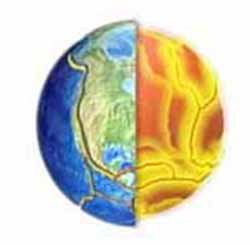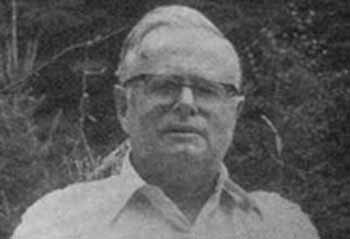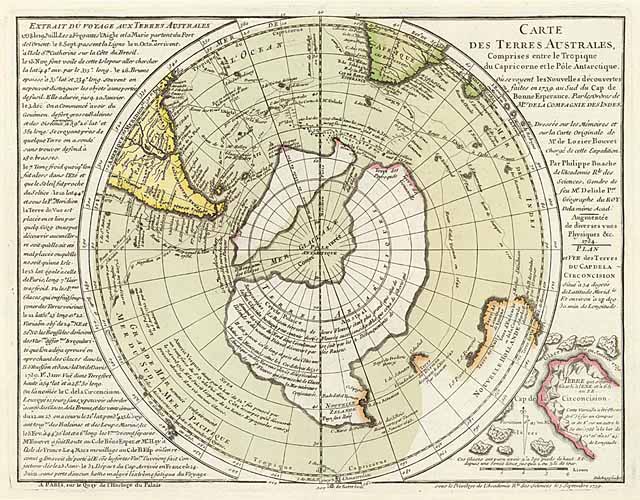

The theory of Crustal Displacement is pseudoscience and states that the entire crust of the Earth can shift in one piece like the lose skin on an orange.
By studying the carcasses of the woolly mammoth and rhino found in the northern regions of Siberia and Canada one can see the land these animals gazed on was suddenly shoved into a much colder climate. Their stomachs reveal food found in warm climates where they grazed just prior to their deaths. This was found frozen along with them suddenly. Thousands of animals were found to be frozen in a brief moment of geological time. Ancient maps of Antarctica suggests that it too was 'frozen over' in a brief moment in time.
It has been suggested that approximately 12,000 years ago there was a displacement of the Earth's crust. The entire outer shell of the earth moved approximately 2,000 miles. When the Earth's crust shifted all of Antarctica was encapsulated by the polar zone. At the same time North American was released from the Arctic Circle and became temperate. This is based on the theory of Continental Drift - Earth's continents slowly drifting apart over millions of years. This is possible because the outer crust of the Earth floats upon a semi-liquid layer.
A pole shift theory is a hypothesis based on geologic evidence that the physical north and south poles of Earth have not always been at their present-day locations; in other words, the axis of rotation had shifted. Pole shift theory is almost always discussed in the context of Earth, but other solar system bodies may have experienced axial reorientation during their existences.

Charles Hapgood (May 17, 1904 - December 21, 1982) was an American college professor and author who became one of the best known advocates of a pseudo-historical claim of a rapid and recent pole shift with catastrophic results.
Hapgood received a master's degree from Harvard University in 1932 in medieval and modern History. His Ph.D. work on the French Revolution was interrupted by the Great Depression. He taught for a year in Vermont, directed a community center in Provincetown, and served as the Executive Secretary of Franklin Roosevelt's Crafts Commission. During World War II, Hapgood worked for the COI which later became the Office of Strategic Services (OSS) and the Central Intelligence Agency (CIA), then for the Red Cross, and finally served as a liaison officer between the White House and the Office of the Secretary of the War.
After World War II, Hapgood taught history at Springfield College in New Hampshire. While there, a student's question about the Lost Continent of Mu prompted a class project to investigate the lost continent of Atlantis, leading Hapgood to investigate possible ways that massive earth changes could occur.
In 1958, Hapgood published The Earth's Shifting Crust which denied the existence of continental drift and featured a foreword by Albert Einstein that was written before the theory of plate tectonics was developed. Hapgood speculated that the ice mass at one or both poles over-accumulates and destabilizes the Earth's rotational balance, causing slippage of all or much of Earth's outer crust around the Earth's core, which retains its axial orientation.
He argued that each shift took approximately 5,000 years, followed by 20,000- to 30,000-year periods with no polar movements. Also, in his calculations, the area of movement never covered more than 40 degrees. Hapgood's examples of recent locations for the North Pole include Hudson Bay (60° N, 73° W) , the Atlantic Ocean between Iceland and Norway (72° N, 10° E) and Yukon (63° N, 135° W).
However, in his subsequent work The Path of the Pole, Hapgood conceded Einstein's point that the weight of the polar ice would be insufficient to bring about a polar shift. Instead, Hapgood argued that the forces that caused the shifts in the crust must be located below the surface. He had no satisfactory explanation for how this could occur.
In Maps of the Ancient Sea Kings (1966) and The Path of the Pole (1970), Hapgood proposed the hypothesis that the Earth's axis has shifted numerous times during geological history.
In Maps of the Ancient Sea Kings he supported the suggestion made by Arlington Mallery that a part of the Piri Reis Map was a depiction of the area of Antarctica known as Queen Maud Land. He used this map to propose that a 15° pole shift occurred around 9,600 BCE (approx. 11,600 years ago) and that a part of the Antarctic was ice-free at that time, and that an ice-age civilization could have mapped the coast. He concludes that "Antarctica was mapped when these parts were free of ice", taking that view that an Antarctic warm period coincided with the last ice age in the Northern hemisphere, and that the Piri Reis and other maps were based on "ancient" maps derived from ice-age originals.
Hapgood created his theory documenting three Earth crust displacements in the last 100,000 years. Some researchers believe that they happen every 41,000 years and that the last one happened 11,500 years ago. Hapgood believes that this cataclysmic shift is caused by imbalanced ice at the polar caps. Over time ice builds up at the poles reaching as much as two miles in thickness.
Later research concerning the paleoclimatology and ice sheets of Antarctica have completely discredited the interpretations by Hapgood that an Antarctic warm period coincided with the last ice age in the Northern hemisphere and any part of it had been ice-free at and prior to 9,600 BCE (approx. 11,600 years ago).
Hapgood also examined a 1531 map by French mathematician and cartographer Oronce Fine. In Maps of the Ancient Sea Kings, he reproduces letters received from the chief of a U.S. Air Force cartography section stationed at Westover AFB in 1961. At Hapgood's request, they had studied both Piri Reis and Oronce Fine maps during their off-duty hours, concluding that both were compiled from original source maps of Antarctica at a time when it was relatively free of ice, supporting Hapgood's findings.
Conclusions
Hapgood concluded that advanced cartographic knowledge appears on the Piri Reis map and the Oronteus Finaeus map, and must be the result of some unknown and advanced ancient civilization that developed astronomy, navigational instruments, plane geometry and trigonometry, long before Greece or any other known civilization.
Criticism
According to historians Paul Hoye and Paul Lunde, while Hapgood's work garnered some enthusiasm and praise for its thoroughness, his revolutionary hypotheses largely met with skepticism and were ignored by most scholars.
In the book The Piri Reis Map of 1513 Gregory C. McIntosh examines Hapgood's claims for both maps and states that "they fall short of proving or even strongly suggesting that the Piri Reis map and the Fine map depict the actual outline of Antarctica."
Hapgood's unorthodox interpretations such as "Earth Crustal Displacement" were never accepted as valid competing scientific hypotheses, yet his ideas have found popularity in alternative circles. Librarians Rand and Rose Flem-Ath as well as journalist Graham Hancock base portions of their works on Hapgood’s evidence for catastrophe at the end of the Last Glacial Maximum. Hapgood's ideas also figure prominently in the 2009 sci-fi/disaster movie, "2012."
According to Graham Hancock's Fingerprints of the Gods, the remains of this civilization lie buried beneath the Antarctic ice cap where it was destroyed and buried by Earth crustal displacement.
The map below published by Graham Hancock in his book is considered evidence that Antarctic was already known before its effective exploration. The map was created by Philippe Buache, published certainly after 1739 since in its notes there is reference to the journey of Charles Bouvet, who reached the new lands south of Cape of Good Hope the first of January of the same year. Actually the map may seem strange, since the South Pole is placed at the middle of a glacial sea and is surrounded by two wide islands that form a huge austral continent. In this case the similarity with Antarctic is really poor but the fans of mysteries do not discourage because of this and say that this map represent Antarctic before it was covered by glaciers, hundred thousand years ago.

Other theories which are not dependent upon polar ice masses include:
An unusually magnetic celestial object which passes close enough to Earth to temporarily reorient the magnetic field, which then "drags" the lithosphere about a new axis of rotation. Eventually, the sun's magnetic field again determines the Earth's, after the intruding celestial object returns to a location it cannot influence Earth.
These theories are currently not accepted by the scientific community, but debate is ongoing.
Geochemists solve mystery of Earth's vanishing crust PhysOrg - June 26, 2020
Thank goodness for the Earth's crust: It is, after all, that solid, outermost layer of our planet that supports everything above it. But much of what happens below that layer remains a mystery, including the fate of sections of crust that vanish back into the Earth. Now, a team of geochemists based at the Florida State University-headquartered National High Magnetic Field Laboratory has uncovered key clues about where those rocks have been hiding. The researchers provided fresh evidence that, while most of the Earth's crust is relatively new, a small percentage is actually made up of ancient chunks that had sunk long ago back into the mantle then later resurfaced. They also found, based on the amount of that "recycled" crust, that the planet has been churning out crust consistently since its formation 4.5 billion years ago - a picture that contradicts prevailing theories.
Off the Coast of Portugal, the Earth's Crust Might Be Peeling in Two Live Science - May 7, 2019
In 1969, a giant earthquake off the coast of Portugal kicked up a tsunami that killed over a dozen people. Some 200 years prior, an even larger earthquake hit the same area, killing around 100,000 people and destroying the city of Lisbon.Two earthquakes in the same spot over a couple hundred years is not cause for alarm. But what puzzled seismologists about these tremors was that they began in relatively flat beds of the ocean - away from any faults or cracks in the Earth's crust where tectonic plates slip past each other, releasing energy and causing earthquakes.